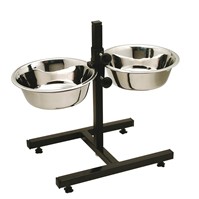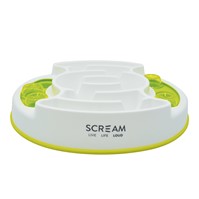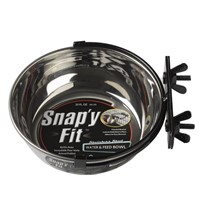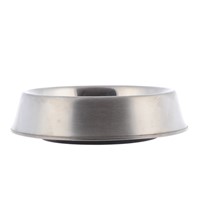
Dog Bowls and Feeders Guide
On average, owners across Australia spend as much as $622 on pet food each year. The fact that 40% of Australians also own dogs points to the fact that a lot of this spending is specifically going towards our much-loved pups, making it hardly surprising that dog bowls which ensure our pooches enjoy these hard-earned feasts are often top of the shopping list for new and existing dog owners.
Picking the best dog bowls from our extensive selection can certainly make mealtimes a little less stressful regardless of fussy eaters, dogs that get a little too keen, or even multiple pooches that scrabble for the best scraps. In this complete guide, we’ll help you to better understand the types of dog bowl available, and how you can ensure that your selection guarantees fuss free dining for your dog(s) during every single meal.
What type of bowl will best suit my dog?
Different dog bowls suit different dogs, and owners will first want to consider the best type of bowl for their unique pup. Taking your time to make the right choice here can especially help your dog to enjoy a range of meal-time benefits that, depending on your choice, may include:
-
Easier eating access
-
Reduced digestion issues
-
Enhanced chewing
-
Cleaner teeth
-
More hygienic eating setups
-
The age of your dog.
Owners often find it especially useful to start their search for the right bowl by considering the materials used, and the different properties/realities of each. Some dogs can be sensitive to particular materials, meaning that if you’re one of those people who often despair ‘why won’t my dog eat out of his bowl?’, this could well be your primary problem. Some materials used to make bowls may have a strong smell which might not agree with a sensitive canine nose. The best dog bowl material for you will generally include one of the following popular options;
Ceramic dog bowls typically include a ceramic coating that allows for a large array of colours and aesthetic designs. Unfortunately, a tendency to crack under pressure means owners who live in extreme temperatures or who aren’t sure how to care for these bowls may be best considering other options.
Stainless steel bowls provide undeniable durability and are a hygienic option being easy to clean. Noise and slipping can be a problem, but non-slip food mats or non-slip bottoms are also an option.
Plastic dog bowls provide an affordable option that also offers many different colours and designs, as well as being generally dishwasher safe for easy cleaning. Plastic bowls are also generally durable, though some dogs can develop mild allergies to plastic during long term use. Some plastic bowls can fade and crack if left outside in the weather. Just like our own plasticware, BPA free is the go.
What to consider when buying a dog bowl
Taking into consideration the material that your dog’s bowl is made of will help to narrow down your options, but don’t forget to keep your dog’s needs in mind.
Owners who skip this can find themselves facing issues later, and if you want to avoid being that owner who despairs why their dog won’t eat out of a bowl after they’ve spent well-earned money on one, then you’ll especially want to consider your dog’s needs beforehand. This should include factors such as:
Your dog’s appetite
Your dog’s appetite is going to make a difference for everything from the size of the bowl you require to the durability necessary to see you through. As such, it always pays to consider appetite specifics including –
-
Feeding quantities
-
Frequency of feeding
-
The type(s) of food your dog eats
Your dog’s energy
Think, too, about your dog’s energy levels, both at mealtimes and in a more general sense. An excitable dog, for instance, will generally benefit from a more durable bowl. Meanwhile, a docile pooch will be far better able to manage a delicate bowl choice and on-the-floor setup.
Is your dog’s bowl indoors or outdoors?
The location of your dog’s bowl also makes a difference, both in terms of how attractive a design you’ll probably want to invest in and also durability itself. Attractive and perhaps less sturdy bowls will certainly suit indoor eating best, while sturdy eating setups, and durable materials that needn’t necessarily look amazing, will work well for outdoor arrangements.
Your dog’s medical needs
Dogs with medical conditions, especially those with digestive, dental, or mobility issues, can also benefit from bowl setups designed specifically to suit their medical condition. As such, considering these needs before purchase can significantly help to improve their eating experiences moving forward, and help you manages some of their symptoms.
Elevated dog bowls

Elevated dog bowls typically involve the placement of two metal bowls in a dog bowl stand that elevates the eating area above-ground for a healthier, easier-to-clean eating setup that can work well both outdoors and in the house Eating in this more upright position makes it easier for the dog to swallow and reduces the strain on its neck. This is not however a good option for large breed dogs that may be susceptible to bloat.
Types of dog that need elevated dog bowls
Dogs can benefit from elevated bowls for a wide range of reasons, but this eating arrangement typically best suits –
-
Dogs experiencing digestive issues or difficulty swallowing.
-
Owners looking for dog bowls for dogs with no teeth or dental issues
-
Small dog breeds or puppies that struggle to get down on the ground
-
Dogs that overly excited at meal times or are generally high-energy
Slow feeder dog bowls

Slow feeder dog bowls like this puzzle dog bowl slow the release of food using a range of challenges that make it harder for your dog to access their meals. This, in turn, can slow down dogs that may otherwise eat too fast, as well as turning meals into an enriching activity that keeps any dog challenged and engaged.
Types of dog that need a slow feeder
A slow feeder dog bowl can be beneficial for any dog who eats too quickly, especially if they suffer from bloat, indigestion, or gas as a result of food-gulping. The increased enrichment and challenge provided by these bowls can also be beneficial for highly excitable dogs, or puppies in the midst of training. This can also be a good option for overweight dogs as it slows their eating, giving the brain time to catch up with the stomach.
Crate bowls

Crate bowls are typically made of durable materials like metal, and include clips so that they can be quickly and securely attached to the bars of a crate to avoid spillages, and ensure that food and water can be easily and cleanly given within the crate itself.
Why your puppy needs a crate bowl
Crate bowls can be great for all manner of reasons, including traveling and convenience, but when a puppy is being crate trained, this purchase can be especially worthwhile. In fact, puppies who spend long periods in their crate (e.g. overnight) generally need crate bowls, and can even benefit from their use in the following ways –
-
Easy access to food and water at all times
-
Associating crate with positive experiences like feeding
-
Avoiding the risk of water spillage, etc.
-
Ensuring your dog still has plenty of floor-space in their crate
Ant-free dog bowls

Leftover food can very quickly start attracting unwanted visitors, with ants being the most common whether you’re feeding indoors or out. Owners who don’t take steps to prevent this often find that infestations can very quickly get out of hand. Ant proof dog bowls that have a deeper base that raises the rim of the bowl can prevent this by stopping access to any food left inside.
Keeping your pet’s area clean
Ant free bowls make it far harder for ants or other unwanted visitors to gain access to your dog’s food, but growing infestations as a result of food left around the floor, or general feeding area mess, can still pose a problem. Left unchecked, this could even see large numbers of ants still finding their way into your kitchen. Understanding the best ways to keep your pet’s food area generally cleaner is the best for avoiding this unwanted and potentially harmful eventuality. Tips that can best help you to do this include –
-
Feeding your dog on a hard, easily cleanable surface: Feeding your dog on a carpet is going to make food spillages impossible to clean. By comparison, feeding them on a hard surface like kitchen tiles or laminate flooring enables you to easily wipe food residue and overspill regularly.
-
Preventing your dog’s bowl from moving: If a dog moves their bowl around a lot when they eat, then they’ll inevitably leave a trail of food for critters to follow. without necessarily knowing where that food has ended up. By ensuring they stick to one spot either using a non-stick bowl mat or a non-stick bowl, you can more easily spot stray food right away.
-
Making sure your dog’s bowl is the right size: Generally speaking, owners should invest in large dog bowls that are larger and deeper than the food they’re going to contain to limit overspill and slow feeding time.
-
Keep on top of cleaning: Tricks and tips aside, the best possible way to keep your pet’s eating area clean is to simply make sure that you’re attending to this task often, ideally after every meal. Food bowls should be washed daily and if feeding any raw food - they should be washed after every meal.
Why your dog might not be eating out of their bowl
In some instances, even dogs who have previously loved their food can go off eating from a bowl. Whether they’ve used that bowl in the past without problem, or it’s a brand new purchase, this can be incredibly frustrating and may see them either removing food from their bowl to eat on the floor or going on a total hunger strike until you remove it for them. As well as spreading mess to places you’d ideally prefer it not to be, this can prevent their enjoyment of meals, and affect their health The following are common reasons why dogs might refuse to eat from their bowls –
-
They don’t like the sound: Metal bowls and even some ceramic options can make a loud sound during eating which may spook or prove off-putting for many dogs. Don’t forget collar tags can bang against a bowl when a dog eats..
-
They struggle to access their bowl: Dogs with mobility issues may struggle to reach bowls on the floor, and may start skipping meals as a result.
-
They’ve developed negative associations: Sometimes, a dog will avoid their bowl due to negative associations, especially if they often experience digestive issues after eating.
-
They just don’t like the way it looks: In some instances, bowl aversions are to do with little more than a dislike for how their bowl looks, either because of colour, design, or just the material in general.
Other dog or puppy essentials for every pet owner
As well as bowls themselves, other essentials can also help your dog and you to enjoy mealtimes a whole lot better, and include –
-
Travel supplies: Dogs need proper eating setups even when you’re travelling, which you can achieve with the help of a collapsible dog bowl or even an automatic dog feeder if your dog will be alone for much of the day.
-
Eating mats: Eating mats provide easy-to-clean, typically non-stick surfaces for your dog’s bowls, and are even available as slow feeding mats if you would rather do away with bowls altogether.
-
Safe storage: Storing food in the correct way is also essential, and can be easily achieved with additions like can covers and secure food/treat canisters.
Wrap up
Most dogs love their food, but small changes like a new bowl can be a major upheaval that could quickly see them refusing to eat. Browsing our full range of bowls and feeding options while keeping the information in this guide in mind makes it far more likely you’ll select products that you’ll both love and that you can keep on using for years to come.